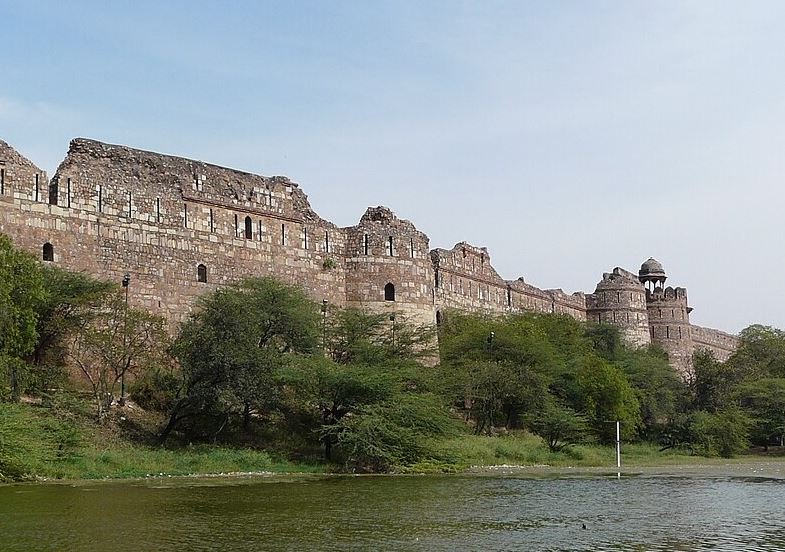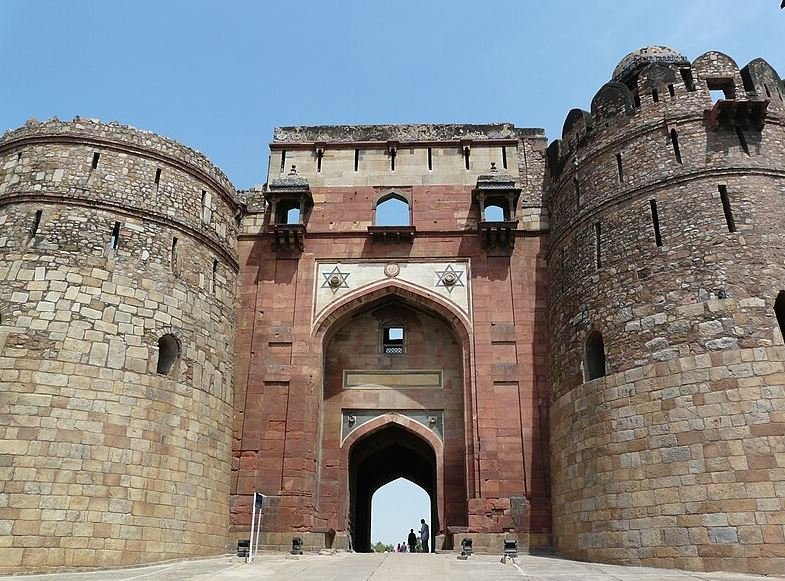History of Purana Qila
Purana Qila, which translates to “Old Fort,” is one of the oldest and most historically significant forts in Delhi, India. This imposing structure was initially constructed under the reign of the Mughal Emperor Humayun and later fortified by Sher Shah Suri, the founder of the Sur Empire. Situated near Pragati Maidan and Mathura Road, Purana Qila forms the inner citadel of the city of Dinpanah, a planned Mughal city.

Ramparts of Purana Qila.
Pre-Islamic Habitation and the Indraprastha Theory
Archaeological excavations have provided evidence of human settlement at Purana Qila dating back to 1000 BCE. The earliest findings belong to the Painted Grey Ware culture, a characteristic marker of early Indo-Aryan settlements in northern India.
Notably, B.B. Lal, a prominent archaeologist, conducted excavations in the 1950s and 1970s, unearthing traces of ancient pottery, artifacts, and remnants of structures that suggest a long and continuous occupation of the site.
The fort has been historically linked to the legendary city of Indraprastha, which, according to the Mahabharata, was the capital of the Pandavas. British historian Alexander Cunningham suggested that Purana Qila could be identified with Indraprastha, though he acknowledged that the current fortifications were built by Muslim rulers.
Until the early 20th century, locals referred to Purana Qila as “Pandavon Ka Qila” (Fort of the Pandavas), further cementing its mythological association.
Purana Qila stands as an enduring symbol of Delhi’s layered history, from its ancient roots to its Mughal grandeur and colonial-era significance.
The Establishment of Dinpanah
The origins of Purana Qila lie in the foundation of Dinpanah, a new city envisioned by the Mughal Emperor Humayun. In the early 16th century, Humayun sought to establish a fortified city near the ruins of Indraprastha. Abul Fazl, a historian in Akbar’s court, wrote that Humayun chose this site specifically because of its historical significance. The construction of the fortifications and city walls was almost complete before Humayun was overthrown by Sher Shah Suri in 1540.
Sher Shah Suri, after defeating Humayun, made substantial modifications to the fort, reinforcing its defenses and renaming it Shergarh. Although he made additions to the structure, much of his work was a continuation of Humayun’s original plan. Historical sources remain divided on the extent of Sher Shah’s contributions.
Some accounts state that he constructed new fortifications, while others suggest he simply strengthened Humayun’s existing defenses. Following Sher Shah’s death, the fort continued to evolve, with further modifications made by his successors and later Mughal rulers.

A closeup view of Purana Qila
Purana Qila in Mughal and Later History
Purana Qila played a significant role in Mughal history. In 1556, Hemu, a Hindu king, briefly occupied the fort after defeating Akbar’s forces in the Battle of Delhi. He was crowned inside Purana Qila as Hem Chandra Vikramaditya. However, his rule was short-lived, as the Mughals defeated him in the Second Battle of Panipat within a month.
During the British colonial era, Edwin Lutyens, the architect of New Delhi, aligned the city’s central axis, Rajpath, with Purana Qila. This highlights the fort’s enduring prominence in Delhi’s historical and urban landscape.
Role During the Partition of India
Purana Qila became a crucial site during the Partition of India in 1947. As communal violence erupted, thousands of Muslim refugees fleeing to Pakistan sought shelter within the fort’s walls. Along with Humayun’s Tomb, Purana Qila was converted into a refugee camp that housed over 150,000 people at its peak. The Indian government took control of these camps in September 1947, and they remained operational until early 1948, as trains carrying refugees to Pakistan resumed in October 1947.
World War II and the Internment of Japanese Civilians
During World War II, Purana Qila served as an internment camp for Japanese civilians residing in British India. The British colonial government, anticipating potential threats from enemy nationals, detained over 1,900 Japanese individuals, including women and children.
The camp conditions were harsh, with internees enduring extreme weather conditions, inadequate food, and insufficient sanitation facilities. The Japanese government protested these conditions, but British authorities dismissed the complaints, arguing that the provisions met “Asiatic standards.”
By December 1942, most internees had been transferred from Purana Qila to other camps, but the fort’s role in wartime internment remains a lesser-known aspect of its history.
Excavations and Archaeological Discoveries
Purana Qila has been the site of multiple archaeological excavations, with notable work conducted by the Archaeological Survey of India (ASI) in 1954-55, 1969-73, and more recently in 2013-14 and 2017-18. The excavations unearthed remnants of different historical periods, including the Mauryan, Shunga, Kushana, Gupta, Rajput, Delhi Sultanate, and Mughal eras.
Findings include Painted Grey Ware pottery dating back to 1000 BCE, mud brick structures from the Rajput period, and a fortification wall measuring 30 meters. During the Delhi Sultanate, buildings were constructed over older structures using repurposed bricks. The Mughal phase saw deeper excavations, revealing three distinct structural periods. The artifacts recovered from these digs are displayed at the Archaeological Museum within Purana Qila.
Architectural Features
The fort’s walls rise to a height of 18 meters and span approximately 1.5 kilometers. It has three primary arched gateways:
- Bara Darwaza (Big Gate) facing west, which remains in use today.
- Humayun Gate, named either because it was built by Humayun or due to its proximity to Humayun’s Tomb.
- Talaqi Gate (Forbidden Gate), which is steeped in legends and remains one of the most intriguing aspects of the fort.

The west gate of Purana Qila
Each gate is adorned with semi-circular bastions, intricate marble inlays, blue tile decorations, and overhanging balconies known as jharokhas. The architectural details reflect a blend of Rajasthani and Mughal influences, particularly evident in the ornamental chhatris (pavilions) that crown the gates.
Purana Qila’s architectural elegance, mythological connections, and strategic importance have made it one of the most fascinating heritage sites in India.
Notable Structures Within Purana Qila
Qila-i-Kuhna Mosque
Built in 1541 by Sher Shah Suri, the Qila-i-Kuhna Mosque is a striking example of pre-Mughal architecture. The mosque features five pointed arches with true horseshoe-shaped designs, an innovative use of red sandstone, and inlaid marble inscriptions. Originally designed as a Jami mosque for royal prayers, the structure retains remnants of its elaborate decorative elements. An inscription within the mosque reads: “As long as there are people on the earth, may this edifice be frequented and people be happy and cheerful in it.”
Sher Mandal
A prominent octagonal tower known as the Sher Mandal was initially commissioned by Babur and later completed by Humayun. It served as an observatory and a personal library for Humayun. Tragically, this is also the site where Humayun fell to his death in 1556 while descending the stairs after his evening prayers. The structure’s upper floor, adorned with white marble in Mughal style, is now closed to visitors.
Other Notable Monuments
- Khairul Manzil: A mosque built by Maham Anga, Akbar’s foster mother, which later functioned as a madrasa.
- Sher Shah Suri Gate: Also known as Lal Darwaza, it served as the southern entrance to Shergarh.
- Hammam Khana: A bathhouse within the fort complex, reflecting Persian-influenced hydro-architecture.
Cultural Significance and Modern Use
Since the 1970s, Purana Qila has served as a venue for theatrical performances, cultural festivals, and concerts. Notably, the National School of Drama staged iconic plays such as Tughlaq and Andha Yug against its dramatic backdrop. Today, the fort hosts a daily sound-and-light show narrating the history of Delhi’s “Seven Cities,” from Indraprastha to New Delhi.
New Seven Wonders of the World: Definition, Selection, History, & Significance
Frequently asked questions about Purana Qila
Who built Purana Qila, and what is its historical significance?
It was originally constructed by Mughal Emperor Humayun as part of Dinpanah, with modifications and fortifications added by Sher Shah Suri.
What evidence links Purana Qila to ancient Indraprastha?
Excavations have revealed Painted Grey Ware from 1000 BC, suggesting continuous habitation. Some historians, including Alexander Cunningham, identified it with the legendary Indraprastha of the Mahabharata.
What role did Purana Qila play during Sher Shah Suri’s reign?
Sher Shah Suri reinforced the fort’s defenses, completed its walls, and added structures like Sher Mandal and Qila-i-Kuhna Mosque.

What happened at Purana Qila during the British colonial era?
It was aligned with Rajpath in New Delhi’s design by Edwin Lutyens and later used as a refugee camp for Muslims migrating to Pakistan during Partition in 1947.
The British used Purana Qila as an internment camp for Japanese civilians and other enemy nationals, housing over 1,900 people in difficult conditions.
What are the major surviving structures within Purana Qila?
The key surviving structures include the Qila-i-Kuhna Mosque, Sher Mandal (Humayun’s library and observatory), and three grand gateways: Bara Darwaza, Humayun Gate, and Talaqi Gate.

Humayun Gate
How did Humayun die at Purana Qila?
Humayun fell from the steps of Sher Mandal while hurrying to prayers on January 24, 1556, suffering fatal injuries.
What discoveries have been made through archaeological excavations?
Excavations by the ASI uncovered artifacts from the Mauryan, Kushana, Gupta, Rajput, Sultanate, and Mughal periods, indicating continuous habitation.
Today, Purana Qila hosts cultural events, theater performances, and a daily sound-and-light show narrating the history of Delhi’s seven cities.
























